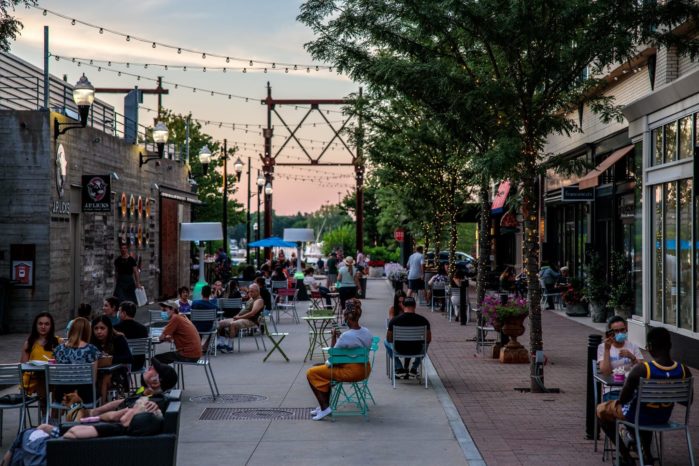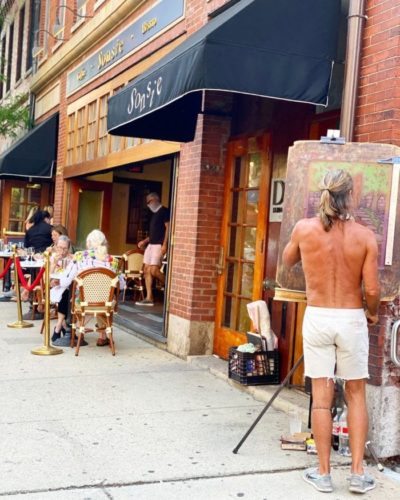
Even considering some of these options before the pandemic might have seemed preposterous
Aside from some chills and light storms that have swept through the region, the past few weeks have seen a near-endless stream of hazy, hot, and humid days in New England, so much so that decades-old records for warmth have been falling by the wayside. This won’t go on forever, though, and before you know it, leaves will be turning, furnaces will start to click on again, and enjoyable activities such as outdoor dining will be a thing of the past.
It is this last item that has folks in the restaurant industry petrified, because we’re now at the point where we can safely say that diners simply tend to be more comfortable sitting outside than they do inside.
So, what happens when temperatures drop below freezing and heat lamps no longer work sufficiently enough to keep outdoor diners warm? Well, barring long-term federal assistance (don’t hold your breath), an extremely mild winter (feel free to root for global warming in this case), or a therapeutic/vaccine introduced soon (again, don’t hold your breath), this is the million-dollar question, and you can bet that restaurants across the region are already preparing for this in various ways, including some of the possibilities listed herein.
Takeout/delivery becomes the focus once again
This seems to be the obvious option—at least for some spots—especially for those that had at least a partial focus on takeout and/or delivery before the pandemic first took hold back in March. Fine-dining restaurants and upscale comfort food places might not fare so well with this option, but dining spots that focus on sandwiches, cheap eats, and quick meals may indeed want to consider this as the weather turns colder.
Restaurants reconcept into quick-service places such as sandwich shops, pizzerias, or burrito joints
Even considering such an option before the coronavirus outbreak might have seemed preposterous, especially for places that pride themselves on service and atmosphere, but we are obviously in uncharted territory where anything goes, really. And some higher-end restaurants around the country have done just this, focusing more on foods that are conducive to takeout/delivery, making it an option that might just work in some cases.
Ghost kitchens temporarily replace full-service dining spots
Another idea that would have seemed like a head-shaker until a few months ago, setting up a restaurant space exclusively for delivery with no actual seating or customer interaction is actually an increasingly big thing right now, and while there would no longer be a need for FOH workers, the sad truth is that most options will likely affect hosts, servers, bartenders, and bussers, though unlike the first two options above, this one would be particularly devastating to those workers, making it a worrisome option in that respect.

Weatherproof tents are set up complete with top-quality heat lamps
This option might give restaurants an extra few weeks of outdoor dining, but it may not be worth the extra costs, and it is not a feasible option for places that have relatively little room outside. But it is a possibility for others, especially for those suburban dining spots that have parking lots and a ton of room in general with which to play, though if we end up having an early winter, all bets are off, even for this kind of setup.
Winter farmers markets, grocery “stores” take over restaurant spaces
We saw a little bit of this around the country during the spring when the pandemic really started to ramp up, with otherwise empty dining rooms being used for the selling of everything from produce to olive oil to condiments to cheese to even toilet paper and hand sanitizer. Like some other options, this might seem to take a Band-Aid approach to things, but because it’s all about survival, this could conceivably keep a place puttering along until the warm weather returns.
Hibernation time
When the outbreak first hit, some restaurants in the Boston area and elsewhere immediately shut down completely, with the reasoning seeming to be that having as few expenses as possible for a few months might be able to get them through the crisis. The problem with this option is that it puts a lot of people out of work, plus having two extended shutdowns in the span of one year might be too much for a business to survive, especially considering that rents don’t tend to hibernate.
Restaurants invest in air filtration/purification systems
One of the biggest fears that diners seem to have is the air that is inside dining areas, or more specifically, where the air is coming from and whether there could be airborne viral particles. An effective air sanitizer/purification system inside a restaurant might go a long way to allay these fears, but would it be enough to convince people that they can feel totally comfortable dining inside, or would they just revert to takeout/delivery instead? It’s definitely a tough—and a very risky—call.
Pray for a miracle
This gets back to the point of federal assistance, a nonbrutal winter, and/or a medical breakthrough, and while none of these are risks worth putting money on, perhaps there are some restaurants out there that are willing to take the chance and do little or nothing in the hopes that they will get money from the government to pay their workers (and at least some of the bills), or maybe an endless stretch of sunny days in the 40s in December and January, or a therapeutic/vaccine that hits the market by the end of the year. The big question is, what if a restaurant banks on one, two, or all three of these things to happen, does nothing to prepare, and then none of these actually happen? There’s a good chance you might not be going to that restaurant come March or April because it will no longer be around.
Don’t let the warm weather fool you; it may be almost too stuffy to sit outside with a burger and a beer right now, but we’re not all that far away from nights where you’ll be bracing yourself from the wind in a puffy coat, looking for shelter and maybe a bite to eat. At that point, outdoor dining will no longer be a viable option, and hopefully your favorite restaurants are coming up with contingency plans now when there’s still time.
In the meantime, for those of you who feel comfortable dining on a sidewalk patio in the city or on a deck overlooking the ocean, definitely try to relish these days, not just for yourselves but for dining spots that are in dire need of your business while the weather is still nice.
Marc is the founder of @hiddenboston, a textbook editor, a hike leader for @AppMtnClub, and a food and travel writer and commenter for DigBoston, NBC/NECN, WBZ, WMFO and indie617.

